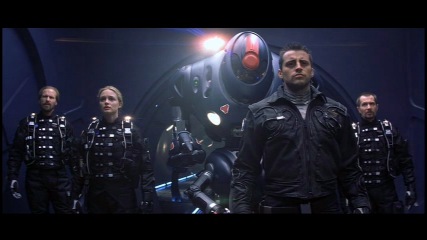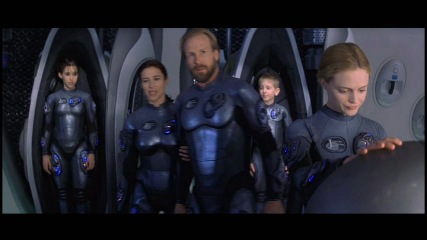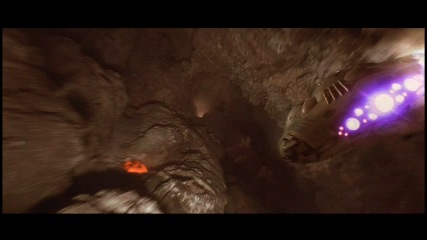|
Lost In Space is one of those enjoyable summer blockbusters; a thrill ride of non-stop special effects wrapped around an entertaining plot. The story begins in 2058 on an earth that has almost used up itís fossil resources. Scientists have built a hypergate through which faster-than-light travel is possible, but can be used only if there is a matching gate on the other side. Otherwise, you could end up anywhere in the universe. So, the space family Robinson embarks on a mission to the only other habitable planet yet discovered, Alpha Prime, to build that gate. However, their 10-year journey is sabotaged after a mere 16 hours by the re-programmed ship robot. Avoiding disaster, the crew of the Jupiter II is hurtled across space and time into the far reaches of the universe, from where they must try and make their way home. To fully enjoy this film, itís important that you leave your rational brain outside the room, and just enjoy the view.

On a purely technical front, Lost In Space is nearly perfect with a reference quality video transfer. Presented in anamorphic 2.35:1 widescreen, Lost In Spaceís numerous special effects are shown without compression or pixelation problems. The layer change, though awkwardly placed in the middle of a conversation between Will and Dr. Smith at 1:30.56 into the film, is completely unnoticeable on my Sony S500D player. I donít mean merely "good", Iím talking about invisible. It makes me seriously wonder why other studios havenít managed to accomplish such clean transitions. Film grain, chroma noise, dirt and jaggies are all equally non-existent. Black levels are well calibrated to the matting, while picture brightness is maintained throughout the film. The movie is 130 minutes long and contains 24 chapter stops.
As one would expect from such a good video transfer, the audio quality in Lost In Space is just as phenomenal. This is what Dolby Digital was meant to be! If you canít impress your friends with the whiz-bang 3D sound in the opening scene itís time for a system upgrade. Directional effects in the split surrounds are frequent and well placed across almost every scene. One such excellent example is on the space ship when the spider creatures are hatching. It really sounds as if they are walking on the ceiling above and behind you.

But wait, you want bass? Weíve got rich, deep bass: subwoofer shake-the-pictures-off-the-wall style bass. Great stuff! There is some minor background hiss if you go looking for it, but otherwise I heard no flaws. Though this disc is rumored to have certain lip-synching problems I was hard pressed to detect them on my player... more noticeable were one or two lines that were re-dubbed. English is the only audio and subtitle language choice.
Somewhat above and beyond the call of duty, two full-length commentary tracks are available. The first is a Director and Writerís track, while the second features the Visual Effects Supervisors, Directory of Photography, Editor and Producer. As befits the Platinum Series label, New Line has packed this disc with many other special features totaling 7.1gb worth of stored data. There are two short featurettes: Building The Special Effects at 16 minutes long and The Future Of Space Travel at 10 minutes in length. Complete cast biographies also feature two short semi-hidden film clips from Dark City and Austin Powers.
Thereís a complete synopsis of all three seasons of the original television show, which also includes a 7 minute interview with the original cast along with more biographies. A Production Design gallery features concept sketches from the various sets and props used in the film. Youíll find the Apollo Four Forty music video from the closing credits along with the original theatrical trailer. Over 11 minutes worth of deleted, unfinished scenes are included. Theyíre very interesting to watch. If you can get by several skill-testing questions relating to the original TV show youíll be treated to a fun, if short, blooper reel.

If youíre a PC computer owner with a DVD-ROM drive youíll be treated to the original, printable screenplay plus many interactive programs. In Create Your Own Planet you help design a world that will sustain life for the Robinsons, Science Planet features science trivia and facts, while Pennyís World includes her [odd] thoughts on life. Dr. Smithís Evil Asteroid includes a lot of little goodies such as Destroy A Planet where you hunt down the Robinsons and a BBS to talk with other people. Moving on, Harmonic Planet lets you compose your own music by mixing different space sounds into a song. Larger programs include Get The Robot, an interactive Robbie the Robot that roams your desktop like a virtual pet, and 3-D Game, a 2-level VRML based program that I couldnít get working. Topping it off are numerous web links and lots of text. Whew! Thereís so much stuff on this disc it gets downright confusing.
I quite enjoyed this film. Itís a non-stop action special effects extravaganzaÖ and at times thatís exactly what Iím looking for. New Line has done an impressive job with this disc, creating a DVD model for everyone else to emulate. If you liked the movie youíll love the quality of the transfer and the countless added features Ė a great bargain at such a low price!
- Reviewed by Daniel Tonks on May 17, 1999.

 |  |
| Movie: |
    |
| Video Quality: |
    |
| Audio Quality: |
    |
| Supplements: |
    |
1-Poor 2-Fair 3-Good 4-Excellent
|
System Equipment
Sony DVP-S500D DVD Player
Sony STR-GA8ES 5.1 Receiver
Sony KV-27V65 27" Television using S-Video
Nuance Spatial & Star Series Speakers
|

| 
